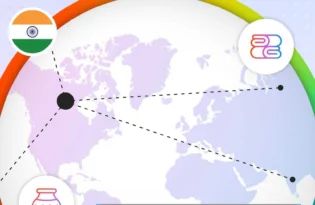How to Receive International Payments in India
For Indian freelancers, e-commerce sellers, and small businesses, working with global clients is easier than ever—yet receiving international payments remains a challenge. With delays, fees, and regulations to navigate, choosing the right method matters. Here’s how options like Payoneer make getting paid faster, easier, and more affordable.

| Table of Contents |
| Challenges When Accepting International Payments in India |
| How to Accept International Payments in India |
| Why Payoneer is the Best Way to Receive International Payments in India |
| How to Receive International Payments in India with Payoneer |
| Frequently Asked Questions (FAQs) |
In today’s global economy, businesses in India rely heavily on international payments. Whether you’re a self-made contractor working with clients from abroad, an e-commerce vendor operating around the world, or a small to medium-sized business (SMB) managing cross-border B2B payments, the ability to send and receive international payments is most likely critical to your bottom line.
However, slow processing times, high transaction fees, and complex regulations make receiving international payments a challenge. Choosing the right payment method is therefore a very important step to securing cost-effective and seamless transactions.
This guide looks at the best ways to receive international payments in India, exploring traditional methods, modern platforms, and how Payoneer stands out from the crowd as the top choice for handling global transactions.
Challenges When Accepting International Payments in India
Receiving international payments in India comes with a host of challenges that can impact your business. Let’s go through the most common issues and their implications.
High Fees and Currency Conversion Costs
Conventional payment methods such as bank transfers or wires using SWIFT often involve hefty fees for processing international transactions. These costs can chip away at your earnings, especially when making frequent and small transactions.
Regulatory Compliance
India has strict regulations for international payments, among which are the documents required under the Foreign Exchange Management Act (FEMA). Freelancers or SMBs unfamiliar with the process and local red tape may find navigating these rules a time-consuming challenge.
Limited Accessibility to Global Payment Platforms
Established platforms like PayPal have limited functionality in India, causing a number of issues when it comes to receiving and accepting international payments in India. This brings about limitations for businesses who wish to cater to clients looking for streamlined payments.
Slow Processing Times
Traditional banking systems often take days and sometimes weeks to process cross-border payments, leading to cash flow delays and operational challenges.
That’s why reliable and efficient solutions are all the more necessary. Platforms like Payoneer address these issues by offering fast, secure, and affordable international B2B payments tailored to the needs of Indian users.
How to Accept International Payments in India
There are many ways businesses in India can receive international payments. Below is an overview of the most popular ones, along with their advantages and disadvantages. Please note, however, that none of the options below should be singled out as the best way to receive international payments in India.
Bank Wire Transfers
Bank wire transfers are the most traditional way of receiving international payments. Funds are sent directly from the sender’s bank account to the recipient’s account using a network for international wire transfers like SWIFT (short for Society for Worldwide Interbank Financial Telecommunication) or CHIPS (short for Clearing House Interbank Payments System) for USD transfers to banks in the US.
Pros:
- Relatively safe for high-value transactions.
- Suitable for long-term business relationships.
Cons:
- High fees for transactions, especially cross-border ones.
- Slow processing times, often taking several business days and prone to delays due to dependence on intermediary banks.
SWIFT Transfers
SWIFT is the most widely used wire transfer network for cross-border payments by financial institutions in India, so it deserves a closer focus. Enough businesses also deem it the best way to accept international payments in India. That said, and while undoubtedly secure, it does come with its own significant drawbacks.
Pros:
- A trusted and secure network for global payments.
- Supported by the biggest banks in India.
Cons:
- If you’re making frequent transactions that are relatively small in amount, using SWIFT gets expensive quickly.
- Setting up the actual process of sending and receiving payments via SWIFT is lengthy and manual compared to online banking through digital wallets.
Digital Wallets
Digital wallets like Payoneer offer a modern and economical way to receive international payments in India. They provide multi-currency accounts, competitive transaction fees, and fast processing times.
Pros:
- Instant access to funds.
- Supports transactions in a wide range of currencies and offers localized withdrawals.
- Ideal for freelancers and any type of SMB.
Cons:
- Requires setup and account verification.
Payment Gateways
Payoneer also serves as a payment gateway, alongside competitors like Stripe and Razorpay, and allows businesses to integrate payment solutions into their websites. This is especially useful for e-commerce businesses.
Pros:
- Easy integration for online vendors.
- Accepts a variety of payment methods, including cards and digital wallets.
Cons:
- Increased fees for international transactions compared.
- May require developer-savvy setup and knowledge of how to comply with local laws.
Among these methods, platforms like Payoneer stand out for their balance of affordability, speed, and accessibility, making them an excellent choice for users in the region. Many businesses deem it the best way to accept international payments in India.
Read more about how to improve your cross-border payment capabilities with Payoneer.
Why Payoneer is the Best Way to Receive International Payments in India
Payoneer is quickly growing into a top choice for many businesses looking to accept international payments in India.
Here’s why so many are gravitating towards it:
Multi-Currency Accounts
Payoneer offers local accounts in a variety of currencies, including USD, EUR and GBP. This eliminates the need for costly currency conversions.
Low Fees and Transparent Pricing
Compared to conventional payment methods, Payoneer charges significantly lower transaction fees, helping you keep more of what you earn.
Fast and Reliable Transactions
With Payoneer, you can receive payments faster than with conventional methods, ensuring a more streamlined cash flow for your business.
Compliance with Indian Regulations
Payoneer complies with local laws and guidelines under FEMA. This makes it a secure and legally compliant option for businesses in India.
Easy Withdrawal Options
Funds received through Payoneer can be withdrawn directly to your Indian bank account in INR. This makes managing your money more convenient.
Integration with Global Platforms
Payoneer easily integrates with global marketplaces like Amazon, Upwork, and Fiverr, making it ideal for freelancers and e-commerce sellers.
Thanks to its wide range of features and tailored solutions for the region, many consider Payoneer to be the best way to receive international payments in India. Learn more.
How to Receive International Payments in India with Payoneer
Setting up Payoneer to receive international payments in India is a simple process.
Here’s a quick step-by-step guide:
Step 1: Sign Up for Payoneer
- Visit the Payoneer website to create your account.
- Navigate to “Receive Payments” and indicate whether you’ll be using your Payoneer account for business or freelancing purposes.
Step 2: Provide Documents for Verification
- Submit essential documents for verification, including a valid government-issued ID (e.g., Aadhaar or PAN card) and proof of your Indian bank account.
- Payoneer complies with local regulations under FEMA, so you may be asked to provide business-related details depending on your circumstances.
Step 3: Link Your Indian Bank Account
- Add your local bank account details so that you can withdraw funds in INR easily.
- Ensure that the bank account is active and matches your Payoneer registration details to avoid any unexpected delays.
Step 4: Share The Necessary Account Details to Receive Payments
- Once your account is set up, you’ll receive virtual local accounts in currencies like USD, EUR, and GBP.
- Share these details with international clients or marketplaces to start receiving payments.
Step 5: Manage and Withdraw Funds
- Use Payoneer’s intuitive dashboard to keep track of your payments and manage your currencies.
- Withdraw funds to your linked Indian bank account whenever you need them in INR.
By following these simple steps, you’ll be set up to start accepting international payments in India in no time.
Read more about how to receive international payments in India with Payoneer.
Frequently Asked Questions (FAQs)
1. What are the charges for receiving international payments in India?
The fees you will pay depends on the payment method you’re using:
- SWIFT Bank Transfers: This is one of the costliest options. The fees often exceed ₹1,000, on top of the unfavorable currency conversion rates.
- PayPal: Charges up to 4.4% of the transaction amount, without including currency conversion fees.
- Payoneer: Some of the most competitive fees in the market, including flat rates for certain transactions and reduced foreign exchange costs.
By choosing platforms like Payoneer, you can significantly improve your bottom line by reducing the overall cost of receiving international payments.
2. Is there a limit on the amount I can receive from abroad?
Business accounts are subject to FEMA regulations, which don’t have fixed limits but require compliance with reporting and documentation guidelines for transactions over a certain threshold (e.g. $10,000).
3. How long does it take to receive international payments in India?
Much like the cost, the processing times depend on the payment method:
- SWIFT Transfers: Typically 2-5 business days.
- Payoneer and similar online solutions: Payments are processed within minutes or hours, depending on the origin.
- Money Transfer Services: Usually instant or same-day delivery.
4. How can I avoid high foreign exchange fees on international payments?
While it’s impossible to avoid paying any fees, you can certainly take steps to reduce them when accepting international payments in India. For example:
- Use platforms like Payoneer, which offer competitive currency conversion rates.
- Do your research on exchange rates before transferring any funds.
- Avoid exchanging funds multiple times (thereby avoiding the foreign exchange fees) by having them in multi-currency accounts until you need them.
Payoneer’s multi-currency accounts allow you to hold and manage funds in USD, EUR, GBP, and more, ensuring better control over conversions. Learn more.
5. Are there any specific RBI regulations associated to accepting international payments in India?
Yes, receiving international payments in India is governed by the Foreign Exchange Management Act (FEMA).
Some of the main regulations include:
- Businesses have to provide purpose codes when receiving payments.
- Individuals have to adhere to LRS limits for personal transactions.
- All transactions have to be reported to authorized dealers or banks.
Payoneer simplifies compliance by integrating regulatory requirements directly into the payment process.
6. What are the best platforms for Indian freelancers to receive international payments?
Payoneer, PayPal, and Wise are the most popular platforms for freelancers in India.
- Payoneer: Ideal for freelancers working with global clients; offers low fees, multi-currency support, and seamless integration with popular freelancing platforms like Upwork.
- PayPal: Widely accepted but costly due to higher transaction and currency conversion fees.
- Wise: Best for low-fee transfers but may lack marketplace integrations.
Payoneer’s all-inclusive features and cost-effective nature make it the best choice for Indian freelancers.
7. What taxes are involved when receiving international payments?
Taxes depend on the nature of the payment.
- Income Tax: Payments received for services rendered (e.g., freelancing or consulting) are taxable as income.
- Goods and Services Tax (GST): Applies if payments are linked to business transactions and exceed the registration threshold.
- Tax Deducted at Source (TDS): A specified percentage is deducted by the payer from the payment amount and deposited with the Indian government for certain types of cross-border payments.
It would be wise to consult with a tax advisor for guidance, especially if you operate a business whose model depends on receiving international payments in India.
Interested in learning more about how to receive international payments in India? Here are a few important links:
- International B2B payments with Payoneer in India
- Sending and receiving international payments
- A guide on how to improve your cross-border payment capabilities
- Get paid by clients
Related resources
Latest articles
-
Optimizing your financial website for AI-powered search algorithms
SWIFT connects 11,000+ banks worldwide, powering secure international transfers. This guide explains how SWIFT works, why it’s still widely used, how to find your SWIFT code, and how Payoneer helps you receive global payments efficiently.
-
How to hire employees in Ireland
Looking to hire employees in Ireland for your US company? Learn about employment in Ireland and how Payoneer Workforce Management makes it easy to hire in Ireland.
-
Planning to hire employees in Indonesia? Here’s a quick guide
Are you looking to hire employees in Indonesia? Learn about hiring in Indonesia and how Payoneer Workforce Management can help American companies hiring in Indonesia.
-
Planning to hire employees in France? Here’s a quick guide
Looking to hire employees in France for your U.S. company? Learn about employment in France and how Payoneer Workforce Management makes it simple to hire in France.
-
Planning to hire employees in Spain? Here’s a quick guide
Are you looking to hire employees in Spain? Learn about employment in Spain and how Payoneer Workforce Management can help American companies hiring in Spain.
-
How to hire employees in the Netherlands
Looking to hire employees in the Netherlands for your U.S. company? Learn about employment in the Netherlands and how Payoneer Workforce Management can help hire in the Netherlands.
Disclaimer
The information in this article/on this page is intended for marketing and informational purposes only and does not constitute legal, financial, tax, or professional advice in any context. Payoneer and Payoneer Workforce Management are not liable for the accuracy, completeness or reliability of the information provided herein. Any opinions expressed are those of the individual author and may not reflect the views of Payoneer or Payoneer Workforce Management. All representations and warranties regarding the information presented are disclaimed. The information in this article/on this page reflects the details available at the time of publication. For the most up-to-date information, please consult a Payoneer and/or Payoneer Workforce Management representative or account executive.
Availability of cards and other products is subject to customer’s eligibility. Not all products are available in all jurisdictions in the same manner. Nothing herein should be understood as solicitation outside the jurisdiction where Payoneer Inc. or its affiliates is licensed to engage in payment services, unless permitted by applicable laws. Depending on or your eligibility, you may be offered the Corporate Purchasing Mastercard, issued by First Century Bank, N.A., under a license by Mastercard® and provided to you by Payoneer Inc., or the Payoneer Business Premium Debit Mastercard®, issued and provided from Ireland by Payoneer Europe Limited under a license by Mastercard®.
Skuad Pte Limited (a Payoneer group company) and its affiliates & subsidiaries provide EoR, AoR, and contractor management services.












